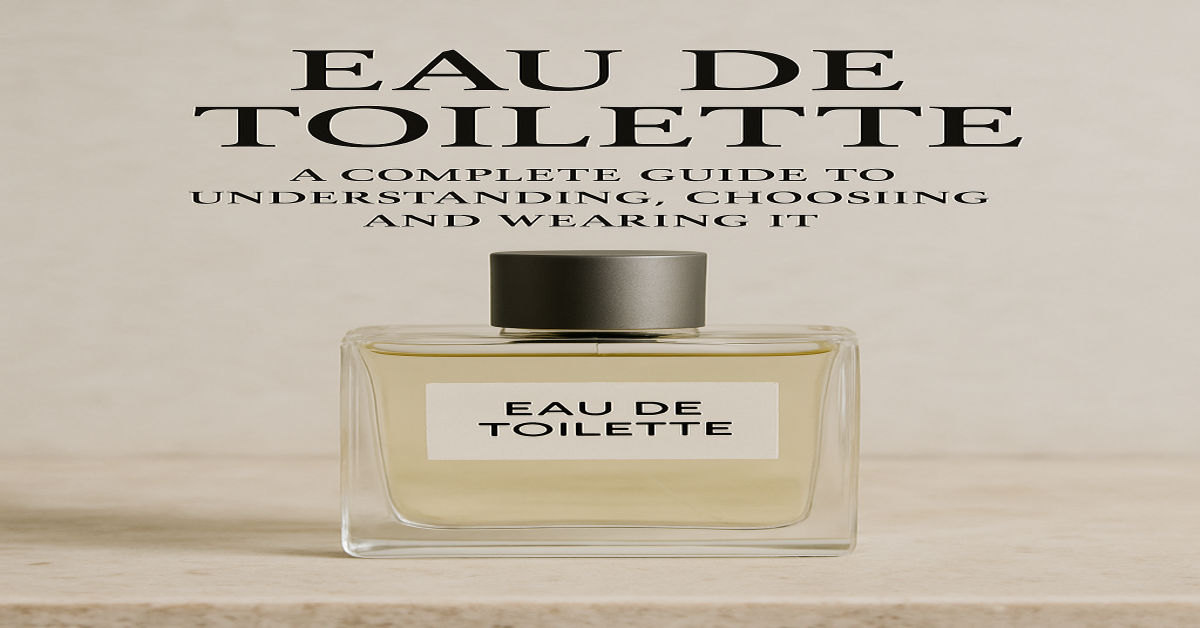Fragrances have long been regarded as more than just pleasant aromas. They are powerful tools of self-expression allowing individuals to communicate mood, personality and style without saying a word. Among the many types of fragrance categories available, eau de toilette stands out for its universal appeal. It is light enough for everyday use yet refined enough to leave a lasting impression. Many people encounter eau de toilette without fully understanding what sets it apart, but those who embrace it often find it becomes a trusted part of their daily routine.
The world of fragrances can feel overwhelming at first with terms like parfume, eau de parfume, cologne and eau de toilette floating around. This guide aims to clear the confusion by breaking down what eau de toilette really means and why it is one of the most balanced fragrance concentrations available. By the end, you’ll not only know how to choose the right one but also how to wear and enjoy it to its fullest potential.
The History and Evolution of Eau de Toilette
The origins of eau de toilette are deeply tied to European grooming rituals of the past. The French phrase “faire sa toilette” literally means the act of getting ready, which often included the refreshing splash of lightly scented water. These early perfumed waters were used by nobility and royals as part of their daily hygiene, adding both cleanliness and luxury to their grooming. Over centuries, perfumers refined these formulations, gradually shifting them from purely practical use to a more symbolic role tied to sophistication and elegance.
By the 19th century, eau de toilette had gained traction as a popular fragrance concentration that was more accessible than perfume but longer-lasting than cologne. Fashion houses and perfumeries began offering eau de toilette versions of their signature scents, allowing a broader audience to experience luxury fragrances. Today, it remains a favorite across the globe, appreciated for its adaptability and for carrying the same heritage of elegance in a lighter, modern format.
What Exactly is Eau de Toilette
At its core, eau de toilette is defined by its concentration of aromatic compounds, usually between 5 to 15 percent. This percentage determines not only the strength of the fragrance but also its performance on the skin. It sits in the middle ground between cologne, which is very light and refreshing, and parfum, which is strong and long-lasting. This makes eau de toilette an excellent option for daytime wear, where subtlety and freshness are often preferred over intensity.
The typical lifespan of eau de toilette is around four to six hours, though factors like body chemistry, climate, and application technique can influence this. For many, this means reapplication may be necessary to maintain the scent throughout the day, which is why bottles are often sold in larger sizes compared to perfume. Its balance of affordability and sophistication makes it one of the most popular fragrance categories worldwide, loved by both men and women.
Key Characteristics of Eau de Toilette
What sets eau de toilette apart are the qualities that make it versatile and wearable for a wide range of situations. It is lighter than perfume, offering a refreshing burst of fragrance without overwhelming those around you. Many formulations focus on top notes that are bright and uplifting, like citrus or light florals, though woody and oriental bases also add depth to some versions. This variety ensures there is an eau de toilette to suit nearly every personal preference.
Another defining trait is its projection, often referred to as “sillage.” Eau de toilette tends to have a moderate trail, making it noticeable when you first enter a room but not overpowering. This balance makes it suitable for professional environments, social outings, and even casual moments at home. Unlike perfume, which might be reserved for special events, eau de toilette is a fragrance that fits seamlessly into everyday life while still offering refinement.
Differences Between Perfume, Cologne, and Eau de Toilette
Understanding the differences between fragrance types is crucial for making the right choice. Perfume, sometimes referred to as parfum, contains the highest concentration of aromatic compounds, often lasting 10 to 12 hours or more on the skin. It is luxurious and deep but comes with a higher price point. Eau de parfum, a slightly lighter version, still delivers strong longevity and richness, lasting around six to eight hours.
Cologne, on the other hand, has the lightest concentration, usually around 2 to 4 percent. It provides a fresh and invigorating effect but fades quickly, lasting only a couple of hours at most. Eau de toilette falls perfectly between these categories, lasting long enough for daily wear while being much more affordable than perfume. This makes it an appealing choice for those who want quality and sophistication without committing to the intensity or expense of higher concentrations.
Comparison of Fragrance Concentrations
| Fragrance Type | Oil Concentration | Longevity on Skin | Best For | Price Range |
| Perfume (Parfum) | 20–30% | 10–12 hours+ | Formal occasions, luxury | High |
| Eau de Parfum | 15–20% | 6–8 hours | Daily and evening wear | Mid to High |
| Eau de Toilette | 5–15% | 4–6 hours | Everyday wear, versatile | Moderate |
| Cologne | 2–4% | 2–3 hours | Quick refresh, casual use | Affordable |
Why Eau de Toilette is Popular Worldwide
The widespread popularity of eau de toilette is largely due to its versatility and balance. Unlike perfumes, which can sometimes feel too heavy for hot climates, eau de toilette offers a refreshing alternative that works across seasons. This makes it especially popular in regions with warm weather, where a light yet noticeable fragrance is more comfortable to wear. The affordability of eau de toilette compared to parfum also makes it accessible to a wider range of consumers.
Fashion houses and luxury brands further enhance its appeal by releasing eau de toilette versions of their iconic fragrances. This allows consumers to experience the DNA of world-famous scents at a more affordable price point. Beyond accessibility, its subtle projection makes it an excellent choice for professional settings and daily life, where a balanced scent is appreciated. This blend of practicality and elegance explains why eau de toilette is beloved by millions worldwide.
How to Choose the Right Eau de Toilette for You
Choosing an eau de toilette starts with understanding your personal preferences. Fragrances are often divided into families such as citrus, floral, woody, oriental, and aromatic. Citrus-based eau de toilette is ideal for those who enjoy fresh, uplifting scents, while floral versions bring elegance and femininity. Woody fragrances, rich with sandalwood or cedar, are perfect for those who prefer warm sophistication, and oriental styles add depth and sensuality with spices and amber.
Testing fragrances on your skin is essential, as body chemistry affects how the scent develops over time. Sampling different options in various seasons or times of day can also give you insight into how versatile a fragrance may be. Many people find it helpful to own more than one eau de toilette—one light and fresh for daytime use and another richer option for evenings. Budget also plays a role, and with so many price points available, there is truly something for everyone.
Choosing Eau de Toilette by Occasion and Season
| Occasion | Recommended Scent Family | Example Notes | Ideal Season |
| Office/Work | Citrus, Aromatic | Bergamot, lavender, sage | Spring, Summer |
| Casual Outings | Floral, Fruity | Rose, jasmine, peach | Year-round |
| Romantic Dates | Oriental, Woody | Amber, sandalwood, vanilla | Fall, Winter |
| Evening Events | Spicy, Warm | Cinnamon, patchouli, musk | Winter |
| Everyday Wear | Fresh, Green | Lemon, green tea, mint | All seasons |
When and How to Wear Eau de Toilette
Eau de toilette is designed to be versatile, but wearing it at the right time enhances its impact. Many prefer to apply it in the morning before work or school, as its lighter composition suits daytime energy. For evenings, especially in social or romantic settings, a slightly heavier application can provide a more noticeable effect. Because it typically lasts four to six hours, reapplication during the day may be necessary if you want the fragrance to carry into the evening.
Proper application techniques can also make a big difference. Spraying directly onto pulse points such as the wrists, behind the ears, or on the neck helps the fragrance diffuse naturally with body heat. Some choose to apply a light mist on clothing, though care should be taken as certain fabrics may alter the scent. Adjusting the number of sprays depending on the environment—fewer for the office, more for a night out—ensures a balanced presence.
Longevity and Performance of Eau de Toilette
The performance of eau de toilette is one of its most discussed aspects. On average, it provides a noticeable scent for four to six hours, though this can vary based on the formula and skin type. Individuals with oily skin tend to hold fragrance longer, while those with dry skin may find it fades more quickly. Environmental factors like temperature and humidity also influence how long a fragrance lasts and how strongly it projects.
There are several ways to enhance longevity. Applying an unscented moisturizer before spraying can help lock in the fragrance. Layering eau de toilett’e with complementary products from the same fragrance line, such as body lotion or shower gel, can also intensify its presence. While it may not match the staying power of parfum, eau de toilette’s refreshing burst and ability to be reapplied make it a practical and enjoyable choice for daily wear.
Eau de Toilette vs. Designer Perfumes
Designer perfume houses often release multiple versions of the same fragrance in different concentrations, including eau de toilett’e. While perfume versions are richer, denser, and longer-lasting, eau de toilett’e offers a fresher interpretation of the same scent. This means the two can complement each other, with eau de toilett’e being worn during the day and perfume reserved for evenings or special occasions.
From a budget perspective, eau de toilett’e provides an accessible entry point into luxury fragrances. Many consumers choose to start with eau de toilett’e before investing in a perfume, allowing them to experience a beloved scent at a lower cost. Both options have their strengths, and owning both can create flexibility in how and when you wear your favorite fragrance. It’s less about choosing one over the other and more about creating a fragrance wardrobe suited to your lifestyle.
Eau de Toilette vs Perfume in Practice
| Feature | Eau de Toilette | Perfume |
| Concentration | 5–15% | 20–30% |
| Longevity | 4–6 hours | 10–12 hours+ |
| Price | Moderate, accessible | High, luxury range |
| Wearability | Daily, professional, casual | Evening, special occasions |
| Fragrance Style | Fresh, airy, lighter interpretation | Deep, rich, long-lasting |
Common Notes and Families in Eau de Toilette
The diversity of eau de toilett’e is reflected in its variety of scent families. Citrus notes like lemon, lime, and bergamot often appear as top notes, giving an immediate sense of freshness. Florals such as jasmine, rose, and lily of the valley add elegance and softness, while woody notes like cedar and sandalwood ground the fragrance with warmth. Oriental influences, including amber and vanilla, bring depth and sensuality.
Aromatic families, featuring herbs like lavender, rosemary, and sage, are particularly popular in men’s eau de toilett’e, offering a crisp and clean profile. Fruity notes, such as peach, apple, or blackcurrant, bring vibrancy and sweetness, often used in more youthful fragrances. Understanding these families helps individuals navigate the vast world of scents, making it easier to select one that matches their personal style, mood, or the impression they wish to leave behind.
Tips for Storing and Preserving Your Eau de Toilette
Proper storage is essential to maintain the quality of eau de toilett’e over time. Light, heat, and air are the three main enemies of fragrance, as they cause the aromatic compounds to break down and lose their original character. The ideal place to store a fragrance is in a cool, dark drawer or cabinet, away from direct sunlight and temperature fluctuations. Bathrooms are not recommended due to their humidity and heat exposure.
To further preserve your eau de toilett’e, always keep the bottle tightly closed after use. Oxygen exposure can alter the balance of the fragrance, leading to noticeable changes in scent. Some collectors even store bottles in their original boxes for added protection. While most eau de toilett’e can last two to three years in good condition, proper storage techniques can extend this lifespan, allowing you to enjoy your fragrance for as long as possible.
Conclusion and Final Thoughts
Eau de toilette is more than just a fragrance concentration—it represents balance, versatility, and accessibility. Its ability to provide a refreshing yet elegant scent makes it suitable for nearly any occasion, from professional settings to casual outings. Unlike perfume, which may feel too heavy for daily wear, eau de toilett’e offers a lighter, more approachable option while still carrying sophistication.
Understanding its history, concentration levels, differences from other fragrance types, and best application techniques ensures you get the most from your eau de toilett’e. By choosing the right fragrance family, wearing it at the right times, and storing it properly, you can make eau de toilett’e a reliable and enjoyable part of your lifestyle. Whether you are new to fragrances or expanding your collection, eau de toilett’e remains a timeless choice that bridges tradition with modern elegance.
FAQs
1. How long does eau de toilett’e last on the skin?
On average, eau de toilett’e lasts around four to six hours, though this can vary depending on skin type, environment, and fragrance formula.
2. Can eau de toilett’e be worn in professional settings?
Yes, its moderate projection makes it ideal for offices or business environments where a subtle yet noticeable scent is appropriate.
3. Is eau de toilett’e only for daytime use?
While it is most commonly worn during the day, many eau de toilett’e options work well for evening events when applied more generously.
4. How should eau de toilett’e be applied for best results?
Apply directly to pulse points such as the wrists, neck, and behind the ears. For longer wear, use on moisturized skin or layer with matching body products.
5. Does eau de toilett’e lose quality over time?
Yes, like all fragrances, it can degrade if not stored properly. Keep it in a cool, dark place away from heat and light to preserve its character.







